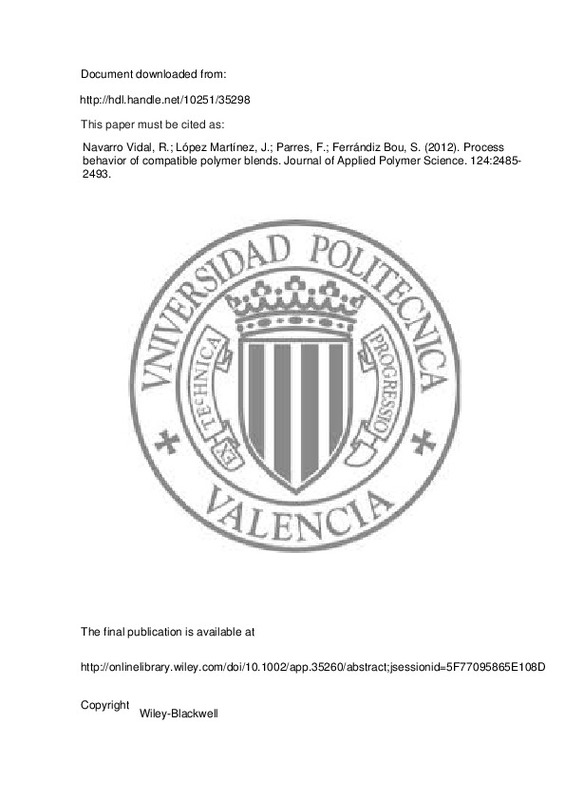JavaScript is disabled for your browser. Some features of this site may not work without it.
Buscar en RiuNet
Listar
Mi cuenta
Estadísticas
Ayuda RiuNet
Admin. UPV
Glass transition and polymer dynamics in silver/poly(methyl methacrylate) nanocomposites
Mostrar el registro sencillo del ítem
Ficheros en el ítem
| dc.contributor.author | Pandis, C.
|
es_ES |
| dc.contributor.author | Logakis, E.
|
es_ES |
| dc.contributor.author | Kyritsis, A.
|
es_ES |
| dc.contributor.author | Pissis, P.
|
es_ES |
| dc.contributor.author | Vodnik, V. V.
|
es_ES |
| dc.contributor.author | Dzunuzovic, E.
|
es_ES |
| dc.contributor.author | Nedeljkovic, J. M.
|
es_ES |
| dc.contributor.author | Djokovic, V.
|
es_ES |
| dc.contributor.author | Rodríguez Hernández, José Carlos
|
es_ES |
| dc.contributor.author | Gómez Ribelles, José Luís
|
|
| dc.date.accessioned | 2013-09-10T11:57:39Z | |
| dc.date.issued | 2011 | |
| dc.identifier.issn | 0014-3057 | |
| dc.identifier.uri | http://hdl.handle.net/10251/31939 | |
| dc.description.abstract | Dynamic mechanical-thermal analysis (DMTA), differential scanning calorimetry (DSC), thermally stimulated depolarization currents (TSDC) and, mainly, broadband dielectric relaxation spectroscopy (DRS) were employed to investigate in detail glass transition and polymer dynamics in silver/poly(methyl methacrylate) (Ag/PMMA) nanocomposites. The nanocomposites were prepared by radical polymerization of MMA in the presence of surface modified Ag nanoparticles with a mean diameter of 5.6 nm dispersed in chloroform. The fraction of Ag nanoparticles in the final materials was varied between 0 and 0.5 wt%, the latter corresponding to 0.055 vol%. The results show that the nanoparticles have practically no effect on the time scale of the secondary ß and ¿ relaxations, whereas the magnitude of both increases slightly but systematically with increasing filler content. The segmental ¿ relaxation, associated with the glass transition, becomes systematically faster and stronger in the nanocomposites. The glass transition temperature T g decreases with increasing filler content of the nanocomposites up to about 10 °C, in good correlation by the four techniques employed. Finally, the elastic modulus decreases slightly but systematically in the nanocomposites, both in the glassy and in the rubbery state. The results are explained in terms of plasticization of the PMMA matrix, due to constraints imposed to packing of the chains by the Ag nanoparticles, and at the same time, of the absence of strong polymer-filler interactions, due to the surface modification of the Ag nanoparticles by oleylamine at the stage of preparation. © 2011 Elsevier Ltd. All rights reserved. | es_ES |
| dc.description.sponsorship | JLGR acknowledges the support of the Spanish Ministry of Science and Innovation through project No. EUI2008-00126 and funding in the Centro de Investigacion Principe Felipe in the field of Regenerative Medicine through the collaboration agreement from the Conselleria de Sanidad (Generalitat Valenciana), and the Instituto de Salud Carlos III (Ministry of Science and Innovation). | en_EN |
| dc.language | Inglés | es_ES |
| dc.publisher | Elsevier | es_ES |
| dc.relation.ispartof | EUROPEAN POLYMER JOURNAL | es_ES |
| dc.rights | Reserva de todos los derechos | es_ES |
| dc.subject | Ag nanoparticles | es_ES |
| dc.subject | Free volume | es_ES |
| dc.subject | Glass transition | es_ES |
| dc.subject | Polymer dynamics | es_ES |
| dc.subject | Segmental relaxation | es_ES |
| dc.subject | Ag nanoparticle | es_ES |
| dc.subject | Broadband dielectric relaxation spectroscopy | es_ES |
| dc.subject | Filler contents | es_ES |
| dc.subject | Good correlations | es_ES |
| dc.subject | Mean diameter | es_ES |
| dc.subject | Methyl methacrylates | es_ES |
| dc.subject | Oleylamine | es_ES |
| dc.subject | PMMA matrices | es_ES |
| dc.subject | Polymer-filler- Interaction | es_ES |
| dc.subject | Rubbery state | es_ES |
| dc.subject | Surface-modified | es_ES |
| dc.subject | Thermally stimulated depolarization currents | es_ES |
| dc.subject | Time-scales | es_ES |
| dc.subject | Acrylic monomers | es_ES |
| dc.subject | Differential scanning calorimetry | es_ES |
| dc.subject | Dynamic mechanical analysis | es_ES |
| dc.subject | Esters | es_ES |
| dc.subject | Filled polymers | es_ES |
| dc.subject | Fillers | es_ES |
| dc.subject | Free radical polymerization | es_ES |
| dc.subject | Glass | es_ES |
| dc.subject | Nanocomposites | es_ES |
| dc.subject | Nanoparticles | es_ES |
| dc.subject | Polymers | es_ES |
| dc.subject | Silver | es_ES |
| dc.subject | Spectroscopy | es_ES |
| dc.subject | Thermoanalysis | es_ES |
| dc.subject.classification | MAQUINAS Y MOTORES TERMICOS | es_ES |
| dc.subject.classification | TERMODINAMICA APLICADA (UPV) | es_ES |
| dc.title | Glass transition and polymer dynamics in silver/poly(methyl methacrylate) nanocomposites | es_ES |
| dc.type | Artículo | es_ES |
| dc.embargo.lift | 10000-01-01 | |
| dc.embargo.terms | forever | es_ES |
| dc.identifier.doi | 10.1016/j.eurpolymj.2011.06.001 | |
| dc.relation.projectID | info:eu-repo/grantAgreement/MICINN//EUI2008-00126/ES/SMART JOINT IMPLANTS USING BIONANOCOMPOSITES/ | es_ES |
| dc.relation.projectID | info:eu-repo/grantAgreement/EC/FP7/218331/EU/Setting up research intensive clusters across the EU on characterization of polymer nanostructures/ | |
| dc.rights.accessRights | Cerrado | es_ES |
| dc.contributor.affiliation | Universitat Politècnica de València. Departamento de Termodinámica Aplicada - Departament de Termodinàmica Aplicada | es_ES |
| dc.description.bibliographicCitation | Pandis, C.; Logakis, E.; Kyritsis, A.; Pissis, P.; Vodnik, VV.; Dzunuzovic, E.; Nedeljkovic, JM.... (2011). Glass transition and polymer dynamics in silver/poly(methyl methacrylate) nanocomposites. EUROPEAN POLYMER JOURNAL. 47(8):1514-1525. https://doi.org/10.1016/j.eurpolymj.2011.06.001 | es_ES |
| dc.description.accrualMethod | S | es_ES |
| dc.relation.publisherversion | http://dx.doi.org/10.1016/j.eurpolymj.2011.06.001 | es_ES |
| dc.description.upvformatpinicio | 1514 | es_ES |
| dc.description.upvformatpfin | 1525 | es_ES |
| dc.type.version | info:eu-repo/semantics/publishedVersion | es_ES |
| dc.description.volume | 47 | es_ES |
| dc.description.issue | 8 | es_ES |
| dc.relation.senia | 212299 |






![[Cerrado]](/themes/UPV/images/candado.png)


